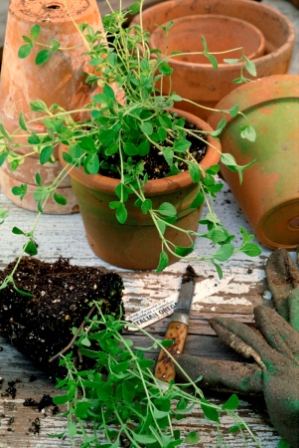At the end of a long summer, thoughts start to turn to more hearty and comforting foods. Italian cooking proliferates with these types of meals and many of them require same basic herb flavorings. Sure, it’s convenient to hop over to the nearest grocery and pick up a plastic container of dried herbs labeled as Italian seasoning, but due to the limited shelf life of many herbs, it may be smarter and more flavorful to produce your own.

There are a few herbs common to most dishes popularly recognized as Italian cooking: basil, oregano, sage, and rosemary. They all play significant roles in different dishes, and each accents sauces, meats and vegetables uniquely, but the synergy of their flavors and scents creates its own distinctive flavor. All of these herbs prefer lots of sun, though rosemary can be tolerant of partial shade. The herbs are also adaptable to container gardening and to in-ground planting. These herb plants also all require well drained soil, with some moisture.
Although a mention of Basil automatically conjures Italian specialties such as pesto and caprese salad, the plant is native to Iran and India, and some types are also found in Asian cooking. Varieties commonly used in Italian and Mediterranean cuisine include Genovese, Purple Ruffles, Lemon, Globe, and African Blue. Purple Ruffles has beautiful reddish curly leaves, and Lemon basil is unusual, as it has a notable lemon scent and flavor due to the plant chemicals limonene and citral. Basil gardeners frequently pinch the immature flowers from basil stems in order to prolong leaf production and to keep woodiness and flavor loss at bay. The flowers of some basil varieties are used as an addition to salads. The flowers only affect the stem that they are on, so a large basil plant could support both stems used for leaves and flowering stems, from which new seeds could be procured. Watch out for yellow leaves at the bottom of the plant; they indicate that the plant needs more sunlight or less water.
Oregano originates from an area closely overlapping basil’s origins. Greek Oregano (O. heracleoticum) is the variety most frequently found in Italian cooking. Its flavor is more robust than Common Oregano (which is also referred to as a marjoram, and properly named O. vulgare), a lightly flavored oregano, which is more commonly used in French cooking. Growers pinch oregano’s flowers to encourage the plant to stay bushy and to prevent bolting. Harvesting before the plant blooms results in the most flavorful cuttings. Oregano maintains its flavor better in hot dishes if added close to the end of cooking; long exposure to heat can make oregano’s flavor turn bitter.
Kitchen sage is part of the large genus Salvia. Sage is a lovely addition to a kitchen garden, with a silvery sheen on leaves that leave a distinct scent when brushed. Salvia officianalis is the common kitchen and garden variety. There are improvements on this basic type, which feature higher yields and essential oil content. Sage also grows very happily in a container. Sage leaves dry well, and make an excellent seasoning for meats as well as a traditional type of tea. White sage is a type grown for First Nations/Native American ceremonial use and is dried and used in smudge sticks and incense. Bees and other beneficial insects are attracted to sage plants, so it’s a good way to get those helpful bugs into the garden.
Rosemary, as Shakespeare’s Ophelia opines, is for remembrance. This unforgettable herb is becoming as popular in landscaping as it is in the kitchen with silvery, piny leaves, robust scent and a delicious flavor, particularly in combination with neutrally flavored chicken and potatoes. Many gardeners opt for a grown plant to avoid the uncertainty associated with growing rosemary from seed, but it’s also quite easy to propagate from a cutting, either in plain water or in root hormone. Snip a two-inch cutting from a healthy plant of the variety and strip bark and leaves from the end. Once roots appear, plant in sterile potting mix and once that’s taken root, treat as a small rosemary plant. Rosemary can do quite well in containers; Blue Boy is a variety known to grow well in limited space. On the other hand, giant varieties like Tuscan Blue can grow to 4-6 feet in the ground; it does pay to remember, though, that rosemary does not like to freeze.
After harvest, try drying your herbs by tying them into small bundles, upside down and hanging them in paper bags in a dry, warm place. Punch holes in the sides of the paper bags and label with the name of the herbs that are drying. In an airy room, the process can take about two weeks, although it’s good to check their progress more frequently. Dried herbs should be stored, whole leaf, in airtight containers, like canning jars, and labeled with date and type. They should be stored out of the light and will keep for about a year. As the leaves lose color, their flavors dissipate. It’s also important to remember, for cooking purposes, that one teaspoon of dried leaves is the same as one tablespoon fresh.
Amy Ambrosius is a writer and budding gardener living deep in the heart of Texas with her family.




Comment here